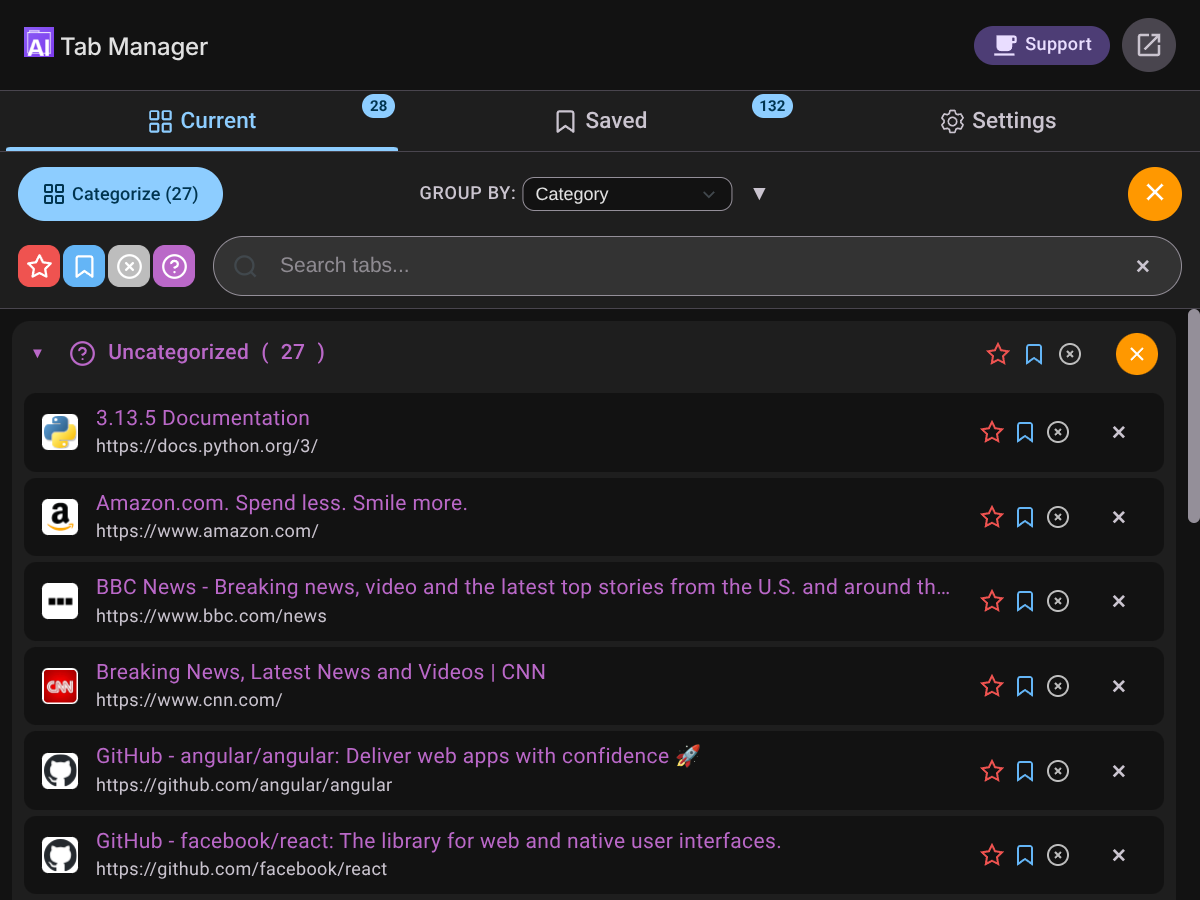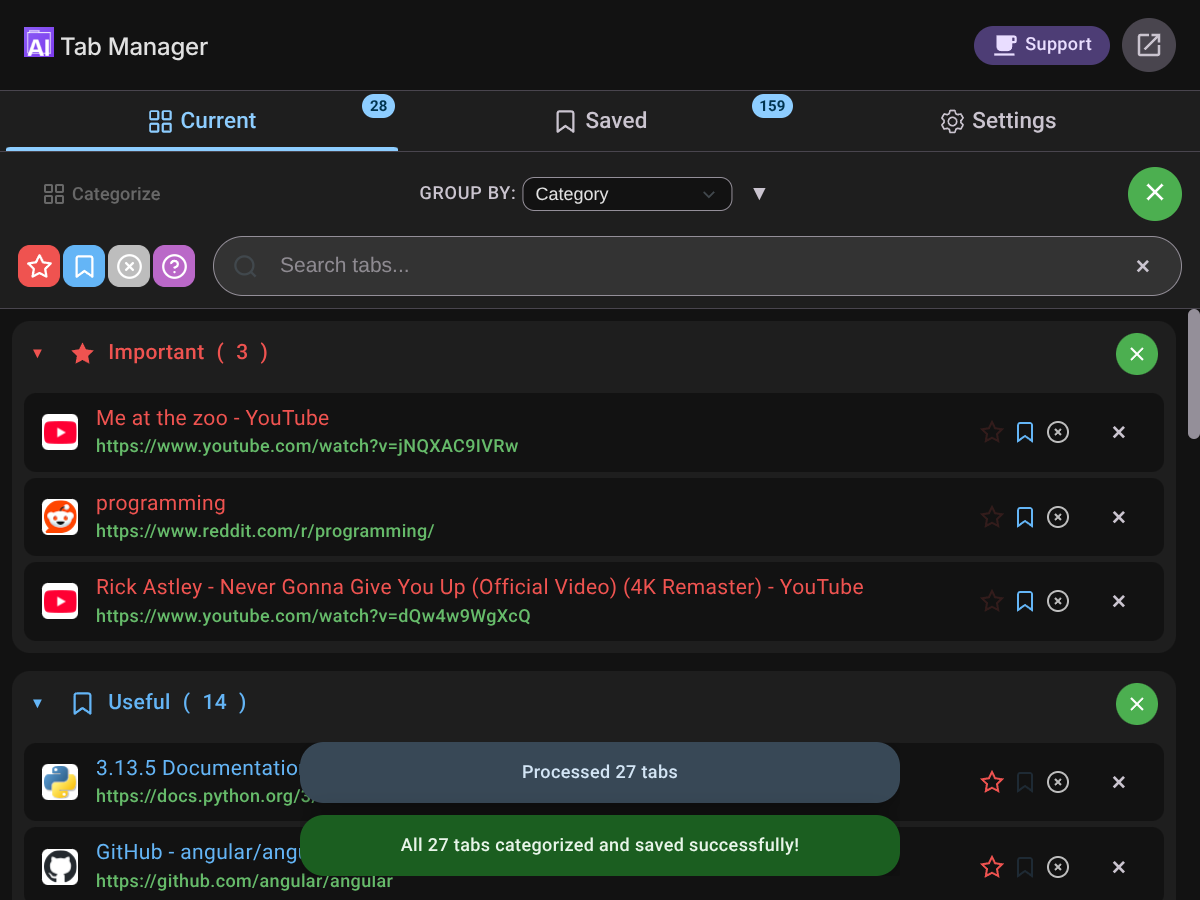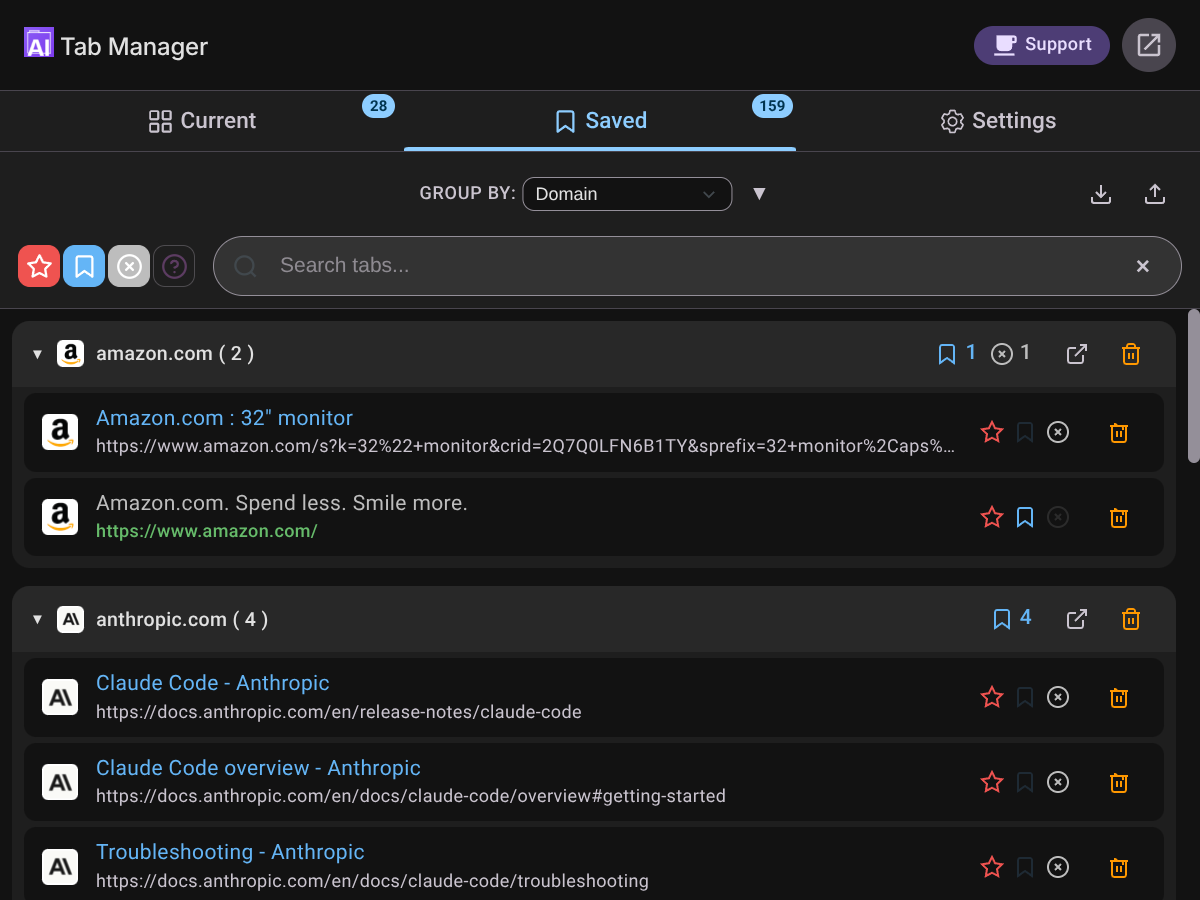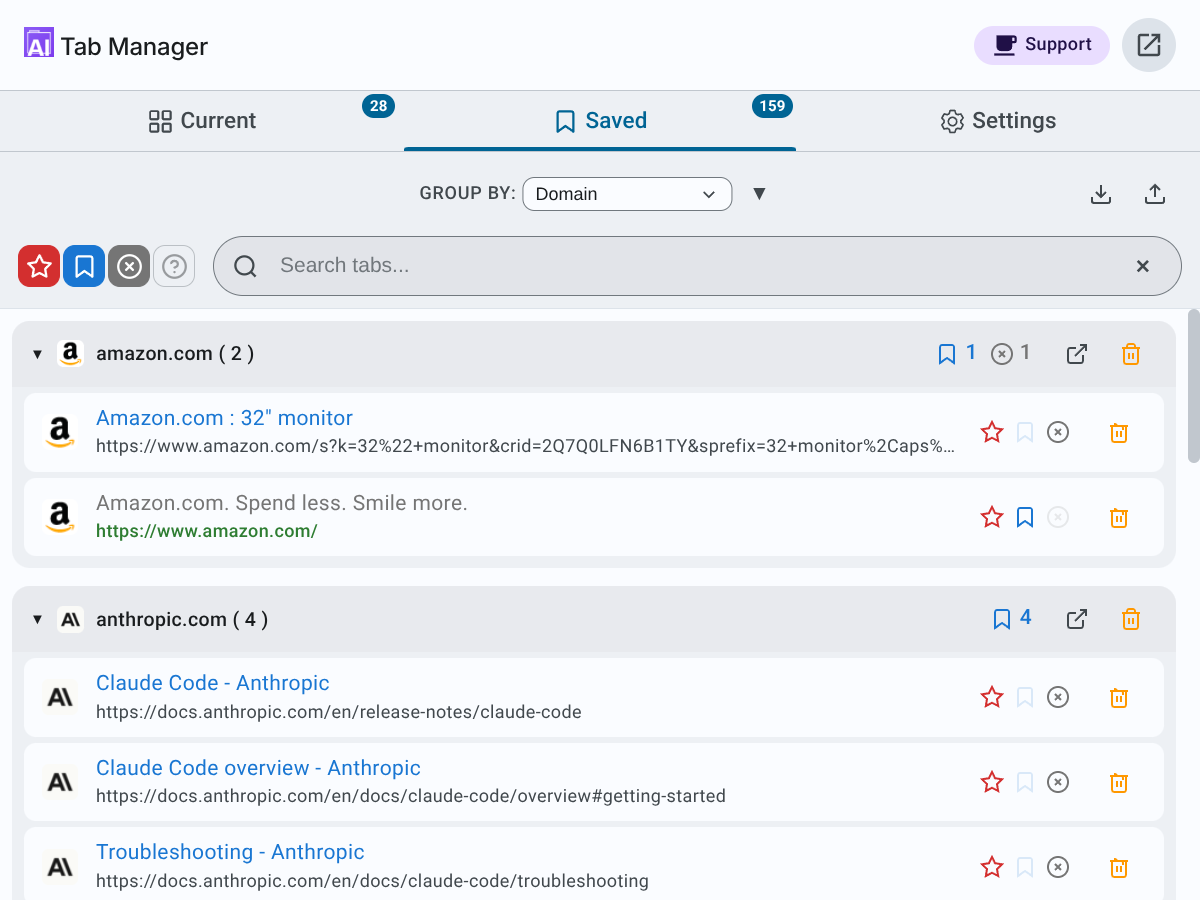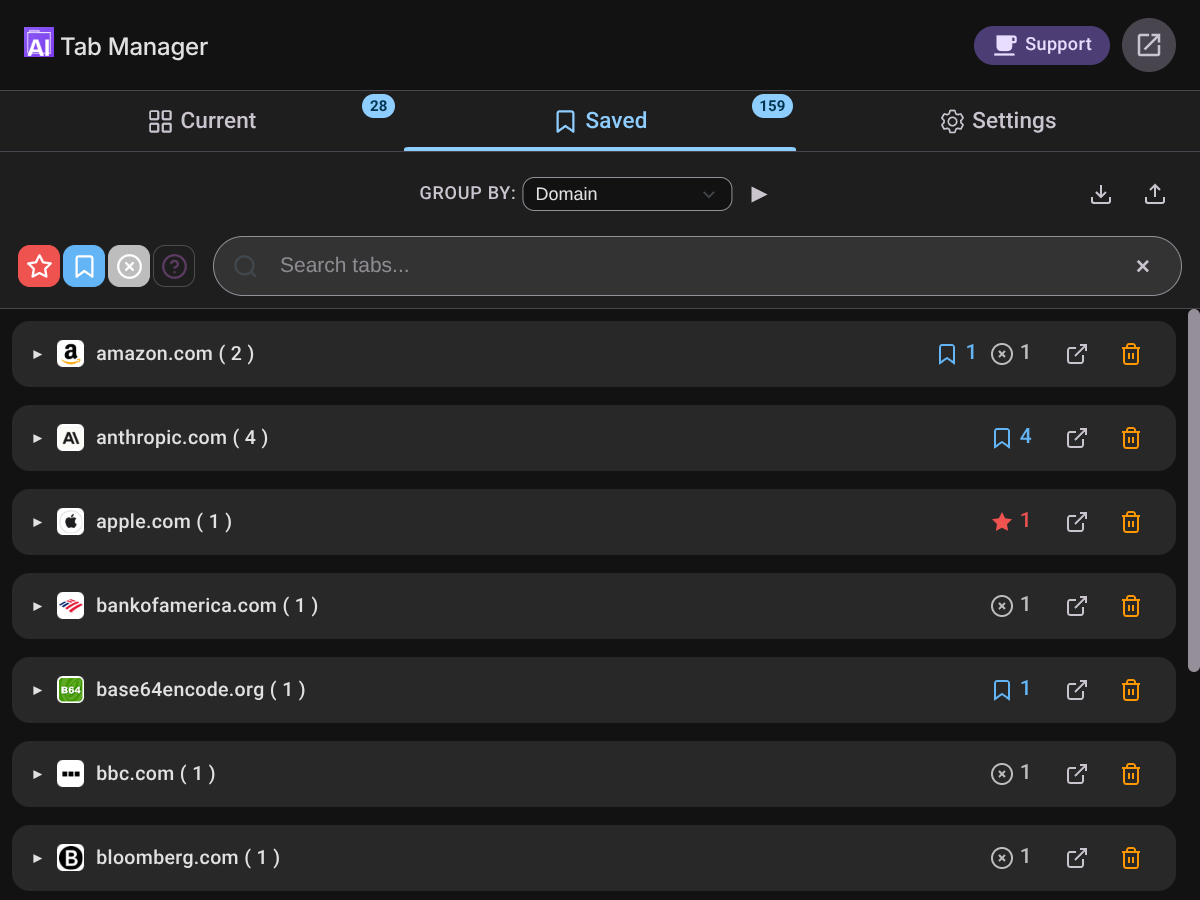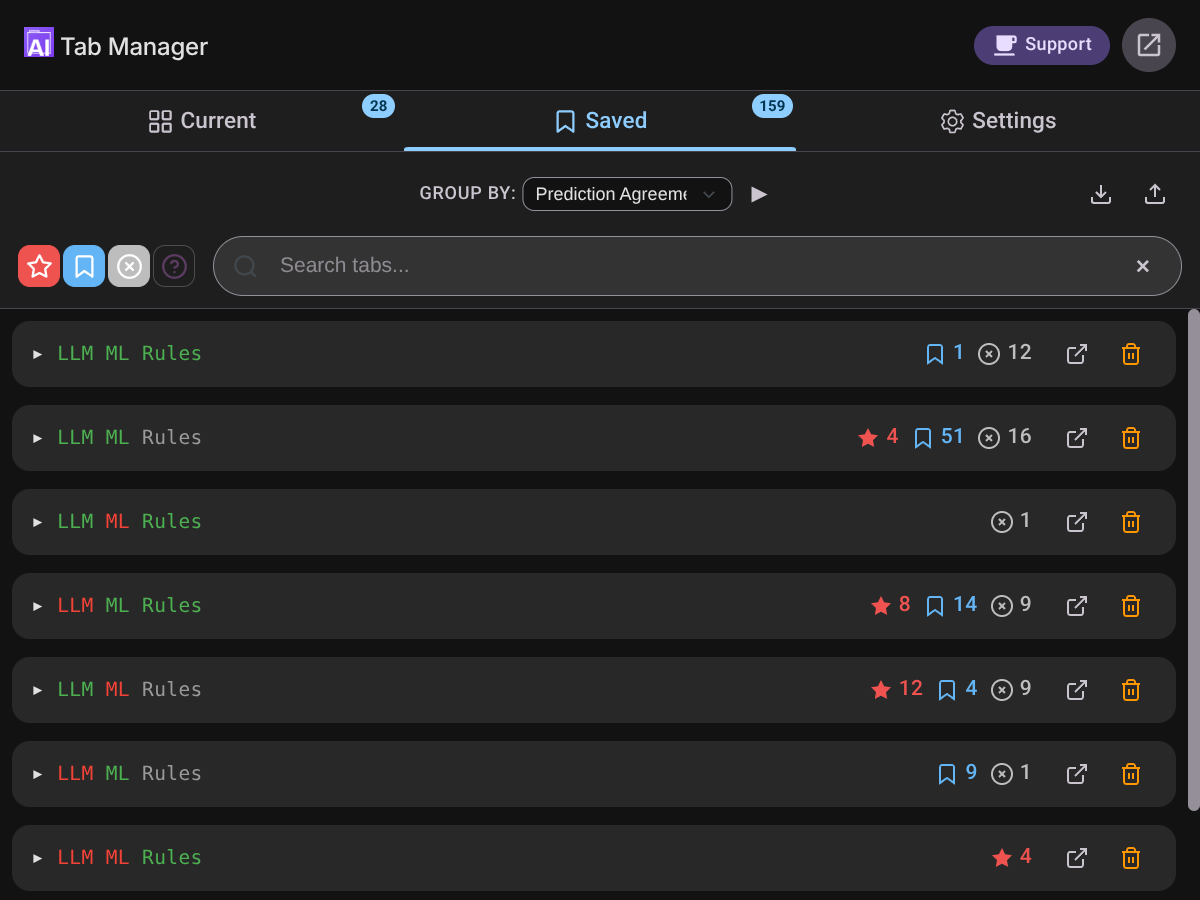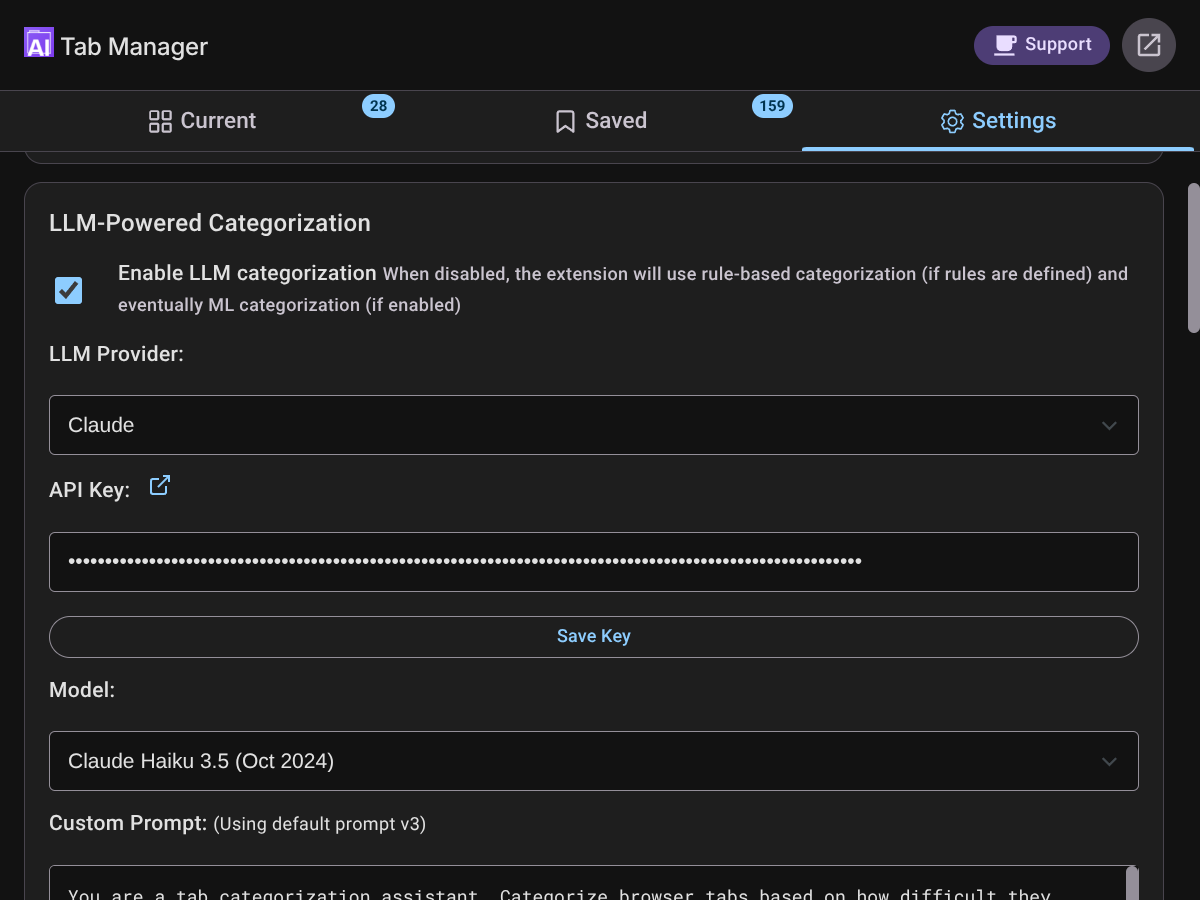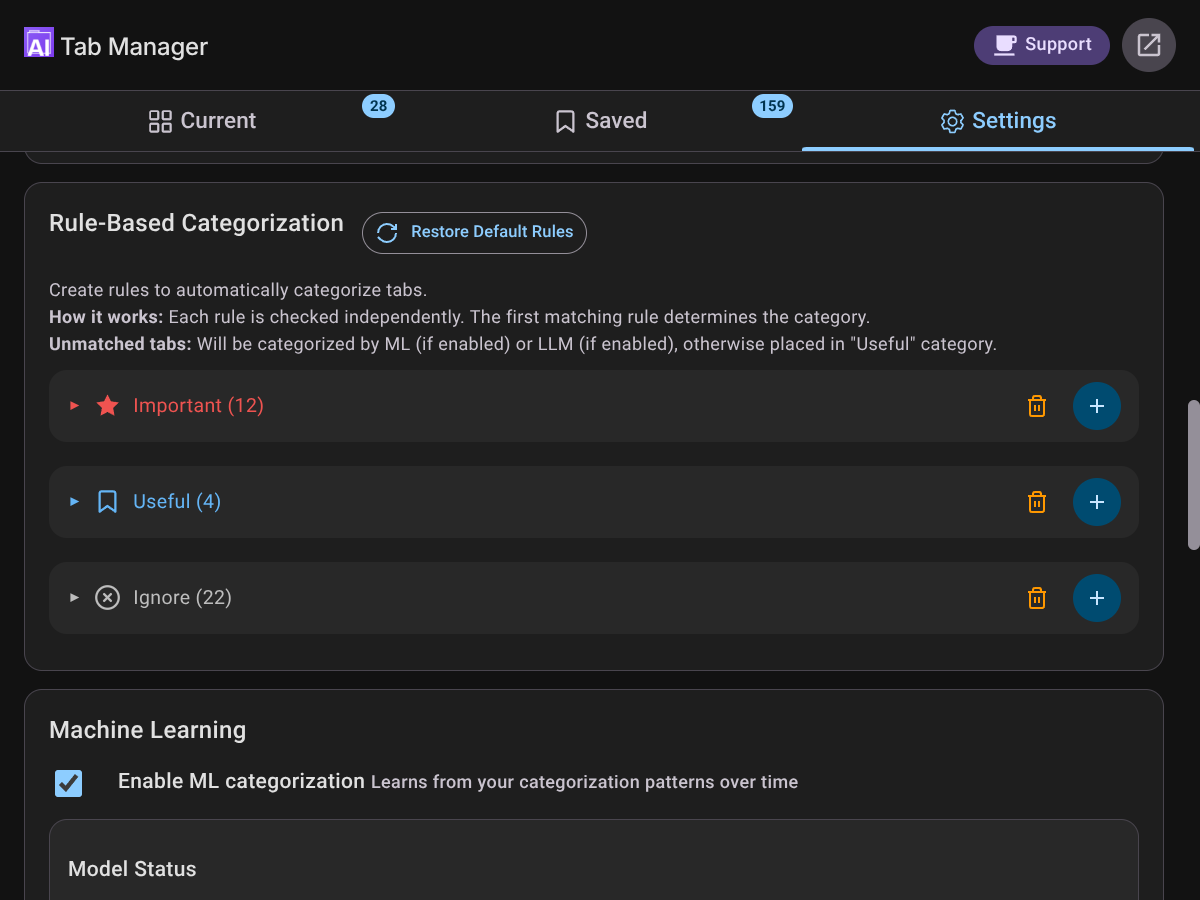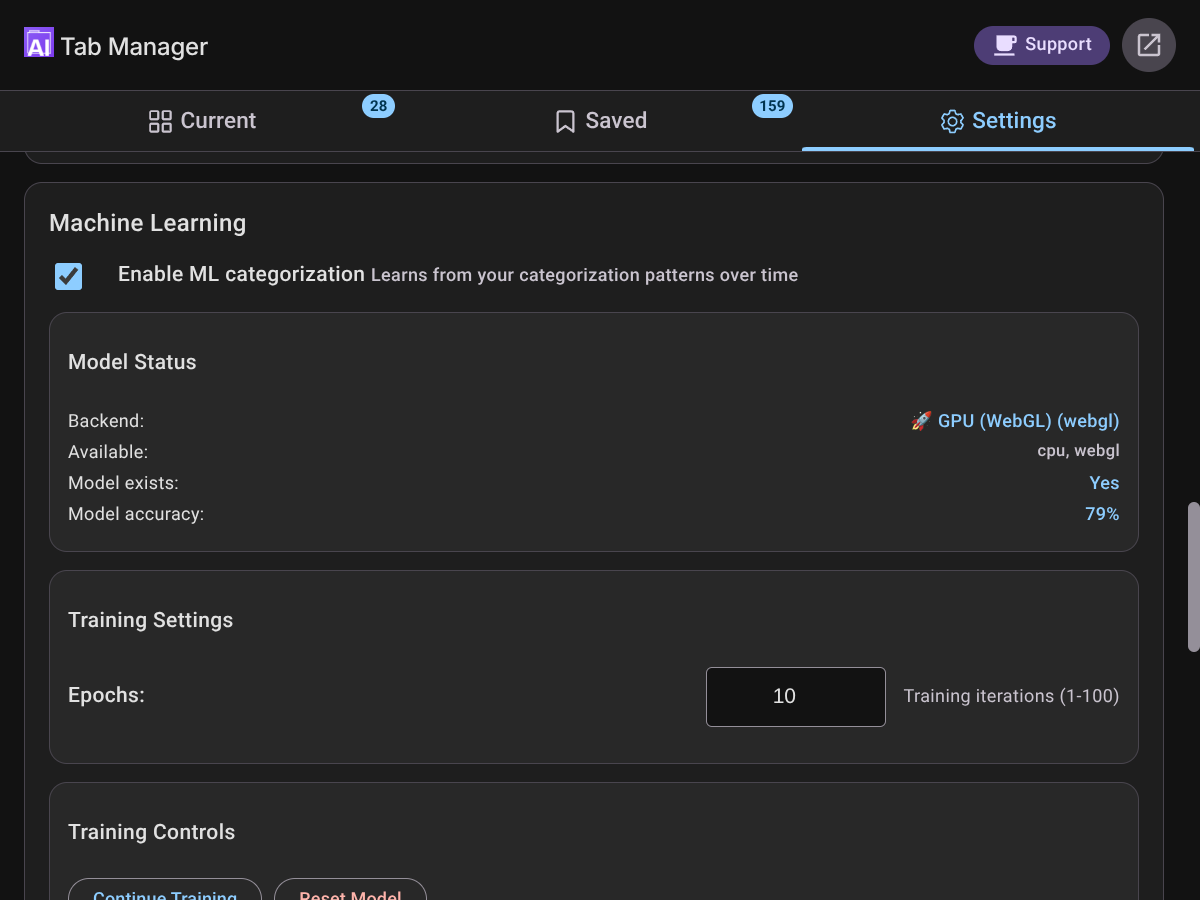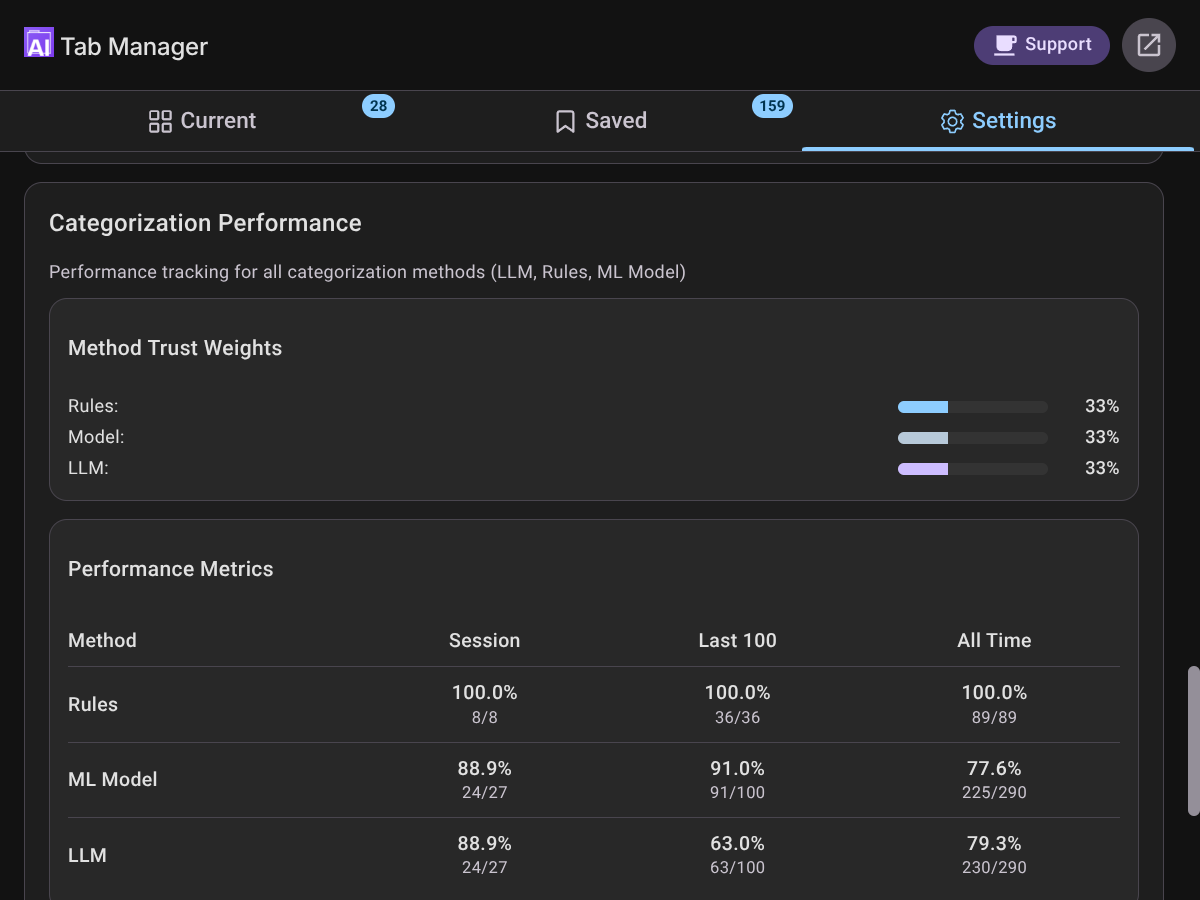 AI Tab Manager
AI Tab Manager
The browser extension that intelligently categorizes and manages your tabs across all windows
The Problem: Tab Overload
If you're like most people, you open a browser window as soon as you need something - whether it's email, Google, or social media. You see an interesting article but don't have time to read it now, so you leave it open. You have a ChatGPT conversation in progress, a YouTube video you want to watch later, and that important documentation page you can't afford to lose.
Before you know it, you have hundreds of tabs open across multiple windows and monitors. You're afraid to close any because they contain important links you might never find again. Even when you know a tab is already open somewhere, you can't find it because you've forgotten the exact URL or title.
The result? A cluttered workspace, degraded browser performance, and the constant anxiety of potentially losing important information.
The Solution: AI Tab Manager
AI Tab Manager solves tab overload by giving you complete control and peace of mind. Here's how:
- See ALL tabs from ALL windows in one place
- Search instantly with multi-word search across titles and URLs
- Group intelligently by domain, time opened, last viewed, or duration
- Categorize automatically using AI to identify what's important
- Save everything so it's completely safe to close tabs
- Return anytime to your saved tabs with full search and filtering
- Export/Import your tab collections as CSV files
- Private Cloud Backup with automatic sync across browsers using your Google Drive
The real magic happens when you click "Categorize" - all your open tabs are automatically sorted into three categories based on how difficult they would be to find again. They're also saved to the database, so you can confidently close everything and return to them later.
See It In Action
Experience the power of AI Tab Manager through these screenshots. Use the arrows to navigate through different features.
The Magic: How Categorization Works
AI Tab Manager uses four methods to categorize your tabs, working together for the best results:
Learn more about each method
1. LLM (Large Language Model) - Optional but Powerful
Uses advanced AI from providers like Claude, OpenAI, Gemini, DeepSeek, or Grok to analyze your tab's URL and title to determine how difficult it would be to find again. No page content is ever sent - only the URL and title.
- Requires an API key from your chosen provider
- Costs approximately $0.001-0.02 per 100 tabs (depending on provider and model)
- Only sends URL + title to the API (no page content)
- Provides the most accurate initial categorization
2. Rules - Your Custom Patterns
Define patterns to automatically categorize sites you visit frequently. Rules support both simple substring matching (e.g., "youtube.com") and complex regular expressions (e.g., "^https?://(www\.)?github\.com/.*"). Rules work together with other methods in an ensemble approach - the final categorization depends on each method's confidence and agreement between methods.
→ Category: Useful (specific videos you want to watch later)
URL Pattern: *google.com
→ Category: Ignore (Google homepage is easy to find)
Useful Regex Patterns
Common Patterns:
• \.(pdf|doc|docx)$ - Match document files
• /issues/\d+ - Match GitHub issues
• \?v=[^&]+ - Match YouTube video IDs
• (mail|inbox) - Match email pages
• localhost(:\d+)? - Match local development
For complete regex documentation, see MDN JavaScript Regex Guide
3. ML (Machine Learning) - Learns From Everything
A local neural network that learns from ALL categorization sources - your manual corrections, LLM predictions, and rule matches. Initially, ML cannot make predictions without training data. As it learns, its confidence grows and it may eventually outvote other methods.
- Runs 100% locally in your browser
- No data ever leaves your machine
- Improves accuracy over time with more data
- Eventually can replace LLM when sufficiently trained
4. Manual - You're Always in Control
Override any automatic categorization by clicking the category buttons on any tab - whether it's uncategorized, already categorized, in Current tabs, or Saved tabs. You can also batch categorize all uncategorized tabs using the category buttons on the Uncategorized group header.
Important: Without LLM enabled, only rules and manual categorization work initially. ML needs training data to make predictions. We strongly recommend enabling LLM at the beginning for automatic categorization of all tabs. Once ML is sufficiently trained, you can disable LLM to save costs.
Privacy Note: Only the optional LLM method sends data externally (just URL + title to your chosen provider). Rules and ML run entirely in your browser. The extension itself never collects or transmits your data.
Understanding Categories
Tabs are sorted into categories based on how difficult they would be to find again if you closed them:
Important
Hard to refind: specific docs, deep search results, work in progress
Useful
Takes effort to find: articles, videos, reference pages
Ignore
Easy to refind: homepages, email, social media
Uncategorized
Not yet processed - waiting for categorization
Interface Guide
Three Main Views
Badge numbers show counts: Current shows total number of tabs opened (including duplicates), Saved shows total number of URLs saved in database.
Layout Components Explained
1. Tab Navigation
- Current: Shows all tabs currently open in ALL browser windows
- Saved: Show all URLs saved in the database
- Settings: Configure LLM, rules, ML, and preferences
2. Toolbar (Two Rows)
Both Current and Saved views have a two-row toolbar with slightly different controls:
Current Tab View Toolbar
Saved Tab View Toolbar
Common Toolbar Features
- Group by dropdown: Available in both views to organize tabs by different criteria
- Collapse/Expand all button: Toggle all groups open or closed at once
- Time granularity buttons: Appear for time-based grouping
View-Specific Toolbar Features
- Current Tab View:
- Categorize button (left) - Run AI categorization on open tabs
- Mute button (left) - Icon-only button to mute all audible tabs across all windows. Only enabled when tabs are playing audio
- Close All button (right) - Close all tabs with safety warnings
- Saved Tab View:
- Export button (right) - Export saved tabs to CSV
- Import button (right) - Import tabs from CSV file
Second Row (Same for Both Views)
Components:
- Category Filter Buttons: Toggle to show/hide categories
- Current tabs: All enabled by default
- Saved tab: Ignore filtered out, Uncategorized disabled (saved tabs shouldn't be uncategorized)
- Search Box: Multi-word search across titles and URLs
3. Content Area - Groups
Content Area Features:
- Collapsible Groups: Click header to collapse/expand
- Progressive Loading: First 20 groups shown, then load more as needed
- Items per Group: First 15 tabs shown, click "Show more" to load additional tabs
- Group Actions: Close/Open/Delete all tabs in group
- Group Category Buttons: Only appear on Uncategorized groups to bulk-categorize all tabs
Scenario: You want to categorize all your uncategorized YouTube videos as "Useful"
Note: Bulk manual categorization only works when grouped by Category
- Make sure "Group by" is set to "Category" (bulk actions only work in this mode)
- In the search box, type "youtube" to filter only tabs with YouTube URLs
- Find the Uncategorized group with your filtered YouTube tabs
- Use the category buttons on the group header to mark all visible YouTube tabs as Useful
- Clear the search to see all tabs again
Smart Matching: Current tabs that match saved URLs are automatically assigned their saved category and shown with a green URL. This is why it's important to save even Ignore category tabs - they'll be auto-categorized when you open them again.
Tab Display & Actions
This button uses AI to categorize all tabs and saves them to the database. Available in the Current tabs view. When there are no uncategorized tabs, the button is disabled.
Category Filter Buttons
Active filters are highlighted with their category color. Click to toggle off and filter out that category.
Sample Tab Items
- Title Color: Matches the category color (Important, Useful, Ignore, Uncategorized)
- Green URL: This tab is already saved in the database (seen in Current tabs view)
- Duplicate Counter: Shows ( 3 ) when multiple tabs have the same URL
- Category Buttons: Click to change category - disabled button shows current category
- Actions: Close button (X) for Current tabs, Delete button (trash can) for Saved tabs
Closing Tabs & Safety Features
The extension uses CSS classes to style the Close All button. When it has the class "has-uncategorized", it turns orange to warn about unsaved tabs. Otherwise, it's green to indicate all tabs are saved.
- Individual tabs: Click the X button to close a single tab
- Group close: Round button on group headers closes all tabs in that group
- Close All: Top-right button closes ALL tabs across ALL windows
- Green button: All tabs are saved - safe to close
- Orange button: Contains unsaved/uncategorized tabs - shows confirmation dialog
Group By Options Explained
Organize your tabs in different ways to find what you need:
- Opened: When the current tab was opened
- Last Active: When tab became active in the browser
- Time Opened: Duration tab has stayed open
- Originally Opened: When URL was opened the very first time
- Last Viewed: When tab was last active
- Saved: When initially saved to database
- Total Age: Time since first open
- Time Since Viewed: Time since last viewed (auto-deletes after 365 days)
- Prediction Confidence: Groups by ML confidence in 10% steps (0-10%, 10-20%, etc.)
- Prediction Agreement: Shows which methods agreed on categorization:
- Green - Method predicted correctly
- Red - Method predicted incorrectly
- Gray - Method didn't make a prediction
Time Granularity Options
When grouping by time, you can choose the granularity:
- 5m: 5-minute intervals - see your most recent activity
- Day: Daily groups - what did you look at today vs yesterday?
- Week: Weekly groups - track tabs from past weeks
- Month: Monthly groups - for long-term tab management
Managing Saved Tabs
Working with Saved Tabs
- Opening tabs: Click any saved tab to open it in the current window (or activate if already open)
- Open group: Click "Open all tabs in group" button - respects the safety limit in settings (default 50)
- Multi-window workflow: Open the extension in different windows to organize tabs across windows
- Deleting tabs: Click trash can icon to remove from database - safe to delete currently open tabs
- Recategorizing: Open tabs → Delete from database → Categorize again with new settings
Export/Import Features
Export Options
- Filter-aware export: Uses current filters (search/category) - export only what you see
- Include ML data: Checkbox option to include prediction and training data for full backup
- When checked: Exports all ML predictions, confidence scores, and training history
- When unchecked: Exports only basic tab information (URL, title, category)
- Full backup capability: With ML data included, importing the CSV restores tabs exactly as they were
Import Options
- Smart duplicate detection: Only imports URLs not already in database
- Import dialog shows:
- Number of rows to import (e.g., "Import 118 rows from CSV?")
- Active categorization methods that will be used
- Number of active rules (e.g., "38 active rules")
- "Ignore categories and recategorize all tabs" checkbox:
- When checked: Ignores CSV categories and recategorizes all tabs using current settings
- When unchecked: Uses categories from CSV, only categorizing tabs without categories
- Auto-categorization: Tabs without categories are automatically categorized using your active methods (Rules, ML, LLM)
- Training metadata preservation: CSV files with ML training data (trainTimestamp, trainSource, trainConfidence) are fully imported and synced with the ML database
Private Cloud Backup & Sync
Your Data, Your Drive: All backup and sync happens through your own Google Drive - no data is ever sent to us or any third parties. Everything is stored in your personal Google Drive's private app folder that only this extension can access.
How It Works
- Automatic Cloud Backup: Your saved tabs are automatically backed up to your Google Drive
- Cross-Browser Sync: Access your saved tabs from any browser where you install the extension
- Real-Time Updates: Changes sync automatically within 5 seconds across all your browsers
- Zero-Knowledge Privacy: Data goes directly from your browser to your Google Drive - we never see it
Getting Started
- Go to Settings → Private Cloud Backup & Sync
- Check "Enable automatic sync"
- Sign in to Google and grant permission to access your Google Drive app folder (one-time setup per Google account)
- Install the extension on other devices where you use the same Google account
- Your tabs will automatically sync across all browsers - no additional setup needed!
Privacy & Security
- Your Google Drive Only: Data is stored in your personal Google Drive app folder
- App Folder Isolation: Only this extension can access its data folder - even you can't see it in regular Google Drive
- No Third-Party Access: Your data never passes through our servers or any external services
- Google's Security: Protected by Google's enterprise-grade security and encryption
Sync Features
- Full Sync Button: Manually sync all data instantly
- Conflict Resolution: Latest changes always win - simple and predictable
- Complete Data Sync: All saved tabs, categories, and ML training data sync together
- Status Indicator: Shows last sync time and current sync status
Install the extension on your work laptop, home computer, and personal devices using the same Google account. After the initial one-time setup, all your saved tabs will be available everywhere, automatically synced through your Google Drive. No additional login required on other devices!
Getting Started
Ready to take control of your tabs? Follow this simple workflow to get up and running in minutes.
First Time Setup (2 minutes)
- Open the extension: Click the AI Tab Manager icon in your toolbar
- First time or after >1 minute: Opens to Current tab with search focused
- Within 1 minute: Returns to your last viewed tab
- See your chaos: All your open tabs from ALL windows appear in the Current tab view
- Configure categorization: Choose one of these options:
- Option A (Recommended): Go to Settings → LLM Settings and set up an AI provider (see quick setup below)
- Option B: Go to Settings → LLM Settings and disable "Enable LLM Categorization" to use only Rules + ML
- Click "Categorize": Watch as your tabs are instantly saved and sorted into categories
The extension expects an LLM provider to be configured. If you try to categorize without setting up LLM, you'll get an error message. Either configure an LLM provider or disable it in settings.
Your Daily Workflow
- Browse normally - Open tabs as you always do
- When overwhelmed - Open the extension and click "Categorize"
- Review quickly - Glance at the categories, adjust any if needed
- Close with confidence - Use "Close All" knowing everything is saved
- Find tabs later - Use the Saved tab view with powerful search and filters
Quick LLM Setup
Setting up AI Categorization (Recommended)
AI categorization helps organize your tabs automatically. The extension shows approximate prices for each model when you select them.
Quick Setup Steps:
- Go to Settings → LLM Settings
- Choose a provider and get an API key (click the link icon)
- Enter your API key and click "Save Key"
- Select a model - the dropdown shows estimated cost per 100 tabs
Choosing a Model:
Important: You don't need the most expensive model! Any contemporary AI model works well for tab categorization. Choose based on your budget:
- Free Options: Google's Gemma models (show as "Free" in dropdown)
- Budget-Friendly: Most models under 5¢ per 100 tabs work great
- Premium Models: Only needed if you want the absolute best accuracy
Pricing Notes:
- Prices shown are estimates and can vary significantly
- Based on categorizing 100 tabs (typical batch size)
- Actual costs depend on tab title lengths and model pricing changes
- Most users spend less than $1/month even with heavy usage
Why Use AI?
- Categorizes ALL tabs accurately on first use
- Understands context from page titles
- Handles new or unusual websites well
- Works alongside Rules and ML for best results
Tip: Start with a cheaper model and upgrade only if needed. The difference in accuracy between models is often minimal for tab categorization.
Using Without LLM (Rules + ML Only)
If you prefer not to use an external AI service:
- Go to Settings → LLM Settings
- Disable "Enable LLM Categorization"
- Set up rules for your common websites (Settings → Rules)
- Manually categorize tabs to train the ML model
Limitations without LLM:
- Only tabs matching your rules will be categorized initially
- Most tabs will remain Uncategorized until you add rules
- ML needs 50+ manual corrections before it starts helping
- Less accurate for new or unusual websites
Tip: Start with broad rules for common sites (youtube.com → Useful, reddit.com → Ignore)
Customize Categorization Rules
Make the extension work exactly how you think:
- Go to Settings → Rules
- Add patterns for sites you visit often
- Use simple text (youtube.com) or regex patterns
- Rules work alongside AI for best results
Example: Mark all local development (localhost) as Ignore
Advanced Features
Custom Prompts
Customize how the LLM categorizes your tabs by modifying the prompt in Settings. This is useful if you have specific criteria for what makes a tab "important" to you.
Rule-Based Categorization
Create rules to automatically categorize websites you visit frequently:
- URL Patterns: Match specific parts of URLs
- Title Patterns: Match keywords in page titles
- Regular Expressions: Use regex for complex patterns
Title: (empty)
→ Category: Ignore (Amazon homepage is easy to find)
URL: *amazon.com/*/dp/*
Title: (empty)
→ Category: Useful (Specific products you're researching)
URL: (empty)
Title: *invoice*
→ Category: Important (Any page with "invoice" in title)
Machine Learning Dashboard
Monitor and control the ML system that learns from your categorization patterns:
- Model Status: See if the model is trained and ready
- Performance Metrics: Track accuracy for each categorization method
- Trust Weights: See how much the system trusts each method
- Training Controls: Manually trigger training or reset the model
- Real-time Training Charts: Watch Training & Validation Loss and Accuracy during training
- Charts persist across popup sessions
- 10-epoch smoothing for cleaner visualization
Tips & Best Practices
For Best Results
- Start with LLM categorization for the most accurate initial sorting
- Define rules for your most frequently visited sites
- Correct any miscategorizations - the ML system learns from your feedback
- Use multi-word search to quickly find tabs (searches both titles and URLs)
- Export important tab collections as CSV backups
- Review and clean up your saved tabs periodically
Performance Tips
- The extension handles thousands of tabs efficiently
- Batch categorization processes tabs in groups for optimal performance
- Search and filtering happen instantly thanks to intelligent caching
- Close tabs regularly - the extension makes it safe to do so
Privacy & Security
Your Data Stays Yours
- Rules & ML: Run entirely in your browser - no external connections
- LLM (Optional): Only sends URL + title to your chosen provider when enabled (or stays completely local with local LLM)
- Extension: Never collects, stores, or transmits your browsing data
- API Keys: Stored locally in your browser, never sent to our servers
- Database: All saved tabs stored locally using IndexedDB
- Local LLM: Complete privacy - run your own AI server for categorization with no external API calls
Open Source: The extension's code is available on GitHub for full transparency. You can review exactly how your data is handled.
Support & Resources
Contact
Email: support@aitabmanager.com
Version Information
© 2025 AI Tech Knowledge LLC
Version: 1.1.0
